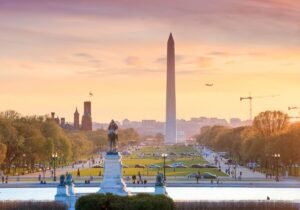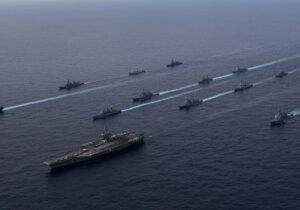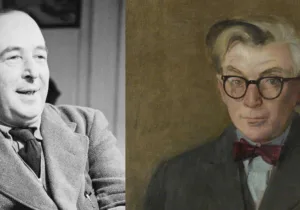Re-foresting The Slash along the Canadian-U.S. border can serve as our overture to Gospodin (Mr.) Putin as we seek to persuade him to withdraw from Ukraine. This peaceful border between our two nations can underscore our appeal to him: “Come now and let us reason together.” Russian satellites can show him this 20-foot de-forested strip along our Northerly border.
The United States invaded Canada three times between 1775 and 1813 and was repulsed. British forces in Canada invaded the U.S. three times—and were forcefully repelled. Our history should be our ally in seeking peace negotiations with the Kremlin over Ukraine. More than two centuries ago, President Madison was forced to retreat from Canada, yet he never lost his office or his life.
Mr. Putin’s worldview is not ours. He doesn’t look back to 1991 as the beginning of modern Russia; he looks back to Kievan Rue. It was the first Slavic kingdom and it goes back to the 11th century. His is an historic view of Russia’s long story and his role in it.
Gospodin Putin has written extensively on the shared history of the Ukrainian and Russian peoples; we should acknowledge there is something to his contentions. That is why he, as Russia’s vozhd (boss), erected a statue outside the Kremlin of St. Vladimir. Ukrainians call him Volodymyr the Great and he is the Father of their nation. It is no small irony that this 21st-century war pits Russia’s Vladimir Putin against Ukraine’s Volodymyr Zelenskyy.
Despite their historic heritage being unevenly yoked, the Ukrainians have yearned for their freedom for most of those long centuries of Russian domination. Think of Irish hostility toward English tyranny.
Or, the Canadians’ resistance to being overwhelmed by Americans. The late Prime Minister Pierre Trudeau was known as the Northern Magus for his ability to resist Yankee pressures. He compared living next to us as sleeping with an elephant.
Gospodin Putin knows his invasion (вторжение) of Ukraine has been a catastrophe (катастрофа). He also knows if he withdraws in defeat, with Russia humiliated, it will cost him his life. It must therefore be our task to persuade him to leave Ukraine without sacrificing his life. A peace settlement could be based on the 1992 Russo-Finnish Treaty, respecting ethnic minorities in both nations and rejecting revenge (месть).
Americans, too, can see The Slash. It extends from Arctic Village, Alaska, to Houlton, Maine. The Slash stretches some 5,525 miles; its purpose is to demarcate the separation between two sovereign states. Its existence is a silent memorial to two hundred years plus of peace along our unarmed Northern border.
Franklin D. Roosevelt knew more about Canada than any other president. He had, after all, summered on Campobello Island throughout his youth. In his 1933 Inaugural Address, FDR may well have had Canada in mind when he announced his approach to foreign policy.
I would dedicate this Nation to the policy of The Good Neighbour–the neighbor who resolutely respects himself and, because he does so, respects the rights of others.
That principle undergirded not only all of Roosevelt’s foreign policy but arguably guided his New Deal.
Ukraine’s courageous resistance proves Gospodin Putin was wrong. He is the most intelligent, most disciplined, most determined, and, alas, most vengeful toward the U.S. of any ruler in Russia’s long history. It’s not just the U.S. and NATO that back Ukraine’s defense.
Kyiv also has the support of most of the Free World. President Zelenskyy’s surprise appearance at the G7 Hiroshima Summit only serves to underscore Gospodin Putin’s diplomatic isolation and his hostility. His unjust war succeeded only in enlarging and energizing the NATO alliance.
We North Americans can offer Russia and Ukrainians our history of two centuries of peaceful coexistence. Different as we are, we share many ideals, many cultural and economic ties, America and Canada have charted our independent paths on this continent. And we have learned to respect each others’ sovereignty.
Re-foresting The Slash could be a dramatic gesture for peace. We could recruit at-risk youth, just as Franklin D. Roosevelt once appealed to train-hopping unemployed young men to join up with his Civilian Conservation Corps (CCC). Roosevelt pointed to the projects the eager youngsters built, many still in use today. Perhaps most important was the President’s praise of the “spiritual” benefits of these young mens’ labors in the woods.
We might partner with Canadian youngsters along the 49th Parallel. We could plant American Scarlet Oaks and Canadian Maples. If the idea takes root, we might ask Russians to donate Siberian Spruce.
Russia, Canada, and the United States are increasingly interconnected as Arctic Powers, more and not less cooperation is imperative. For peace and for the environment of this Good Earth, our re-foresting The Slash could be the model for a Slash between Russia and Ukraine. This would show that planting pines is better than sowing land mines. For Russians and Ukrainians when peace dawns, a better future beckons them both.






 Sponsor a student for Christianity & National Security 2024
Sponsor a student for Christianity & National Security 2024